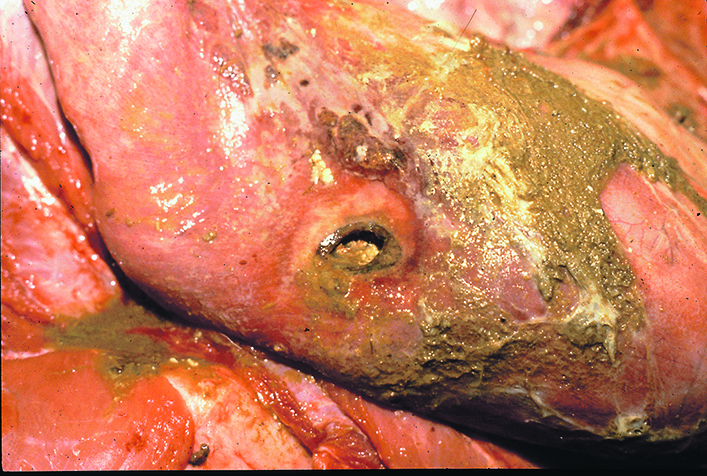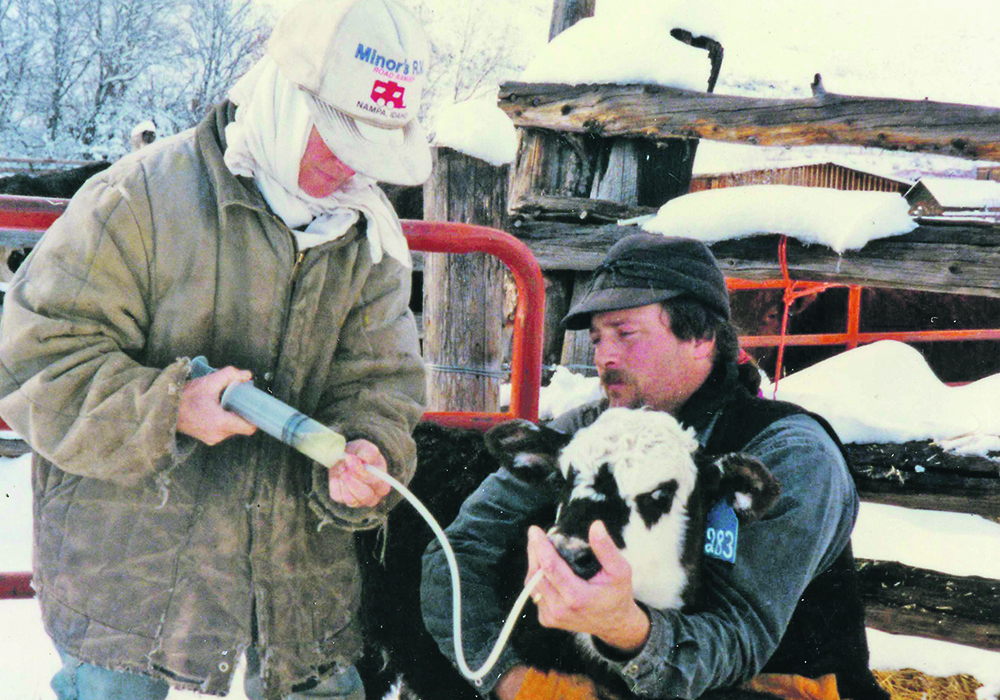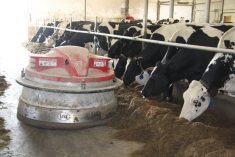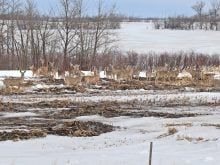An interruption of blood supply to the stomach lining in calves is a common cause, but there are other factors as well
What causes ulcers in young calves?
Dr. Murray Jelinski of the Western College of Veterinary Medicine says the four stomachs in young calves, particularly the rumen, don’t fully function until they are more developed.
Calves depend on the abomasum to digest milk in the first weeks of life.
“Just as in the human stomach, the abomasum is prone to developing ulcers, some of which are subclinical. Others bleed and some become deep enough to perforate,” says Jelinski.
“Acids and digestive enzymes secreted by the stomach can digest a hole in the stomach wall, allowing contents of the abomasum to leak into the abdominal cavity. Calves with perforating ulcers are usually found dead or near death. They usually have a dime-sized hole in the holding part of the abomasum.
“Typically, these calves are three to eight weeks of age as the rumen starts to develop, but we see some as young as four days old,” he says.
An interruption of blood supply to the stomach lining is a common cause, he adds. If blood supply to a certain area is cut off, stomach acid can burn a hole through the lining.
The abomasum in a young calf is full of acid. It needs a healthy mucous-forming membrane lining to protect and buffer it from effects of acid. A plentiful blood supply to the lining normally keeps the mucus-forming cells healthy.
“If you destroy the blood supply, you suddenly have damage from the acid,” says Jelinski.
Calves with bleeding ulcers may pass undigested blood, making the feces black.
The rumen develops as the calf starts eating forage and changes from a single-stomached digester of milk to a ruminant.
“Some calves don’t make that transition smoothly. They may also be licking mud or drinking dirty water from puddles, ingesting microbes. Some get diarrhea and some get abomasitis or a bloated abomasum, a few of which may lead to perforated ulcers.
“Some have a pear-shaped look to the belly, rough hair coat and look dull. Most producers think these calves have ulcers, but you only know if a dead calf has ulcers by doing a post-mortem examination.”
However, many calves with a bloated, sloshing abdomen do get better and it’s unclear whether they had ulcers or merely digestive upset.
Coarse feeds, hairballs or eating dirt are thought by some to irritate the gut lining and lead to ulcers, but Jelinski says these are generally not an issue.
“Ulcers form in the fundus where the musculature is poorly developed and unlikely to generate abrasion. In contrast, veal calves with access to coarse feed such as straw develop shallow erosions in the pylorus (muscular part of the stomach that mixes the food), but don’t have any more incidence of ulcers in the fundus than other calves.”
Jelinski did his early ulcer research on the correlation between hairballs in the abomasum and ulcers but found no connection.
Some calves have trouble making the transition from monogastric to rumen digestion, leading to a situation he calls undifferentiated abomasal dysfunction. The resulting bloat is in the abomasum rather than the rumen.
“If the producer brings one of these poor-doing calves to the vet and the vet opens up the calf surgically, searching for an ulcer, the abomasum is like a huge, fluid-filled sausage. It may contain rank curds of milk, bits of straw, and whatever else the calf has been eating.
“The entire lining is red and irritated, but you don’t see ulcers in those calves. They have abomasitis and we don’t know whether it is from an infection like Clostridium perfringens type A or some other pathogen,” he says.
Diagnosis is challenging because clostridial organisms are often found in the gut of healthy animals. Types A, C and D may be present and never cause a problem, so finding them after a calf experiences a gut problem or dies does not mean they were the cause.
In some cases there may be a toxic infection and if these toxins damage the gut wall, leak into the bloodstream and affect other organs, the calf goes into shock and soon dies.
If it is found before going into shock and treated to halt infection, the calf may survive, although the gut damage may lead to further problems including poor growth and failure to suckle.
“Back in the 1990s, when I was looking at ulcers, doing my master’s with Dr. Eugene Janzen, when we talked to producers who had calves with ulcers, they mentioned calves with slough gut (sloshy gut) that would drink water from mud puddles instead of suckling, and grind their teeth,” Jelinski recalls.
“We decided to call this problem ‘undifferentiated abomasal dysfunction’ because these calves have abomasal bloating and sloshing when they move. If you open them up, there will be foul-smelling undigested material in the stomach.”
Force-feeding can keep these calves alive and eventually they recover.
The sporadic nature of ulcers makes them a challenge to address and study.
“A producer may have 200 to 300 cows and only three calves with confirmed ulcer. The next year the producer vaccinates with a clostridial vaccine, or provides mineral supplement containing copper, or does whatever they think might help, and doesn’t have any calves die of ulcers. They figure they solved the problem, and then a few years later they have ulcers again.”
Jelinski notes ulcers are not all the same. Veal calves have high incidence but few perforations, for example. In beef calves, ulcers tend to occur in the pylorus, which is the muscular part of the abomasum.
“The pylorus is where food is mixing, while the fundus is for temporary storage and digestion rather than mixing. The fundus is where we find ulcers and abomasitis. Producers who report calves with documented perforation also see more calves with abomasal dysfunction,” he says.
As for treatment, antibiotics may be warranted if the calf has a fever. If it is alert but has diarrhea, oral electrolytes can help. Some producers administer oral antacid products or bicarbonate solutions, but Jelinski says they must be given every three to four hours to be effective.
“You can use Tagamet, cimetidine or other H2 blockers used in humans, and there are some better ones today. There’s no doubt this type of product would help to knock off acid production.”
The most important thing is to get rid of the acid. Mineral oil is often given to coat and sooth the irritated stomach lining.

Jelinski has been collaborating on research with Dr. Renee Petri from Agriculture Canada and Alexander Hund from the University of Vienna.
“Alex did a study of ulcers in veal calves and published some microbiology of ulcers. This led to an abomasal ulcer study in Western Canada, with veterinarians submitting cases where they found ulcers, submitting swabs and tissues. We will do a microbiome study, looking at all the bacteria associated with the ulcer,” Jelinski says.
Calves’ dirt nibbling is normal behaviour.
Most young calves nibble dirt and some eat enough to create stomach blockage.
Sand and gravel may irritate the gut lining and create a situation similar to ulcers.
Do these calves eat dirt and sand because they already have an irritation from an ulcer and are off feed and eating strange things? Or does their natural curiosity cause the problem, resulting in gut irritation?
Some think calves eat less dirt if they have proper dietary mineral balance. Supplements may help but won’t completely halt dirt-eating because calves are naturally curious and learn about their environment by tasting things.
“This is actually how they populate the rumen with the proper microbes for fermentation digestion of forages as the rumen develops,” says Jelinski.
Young foals typically eat some of their mothers’ fresh manure to gain the proper microbes, and all young animals go through a stage of licking and tasting.















